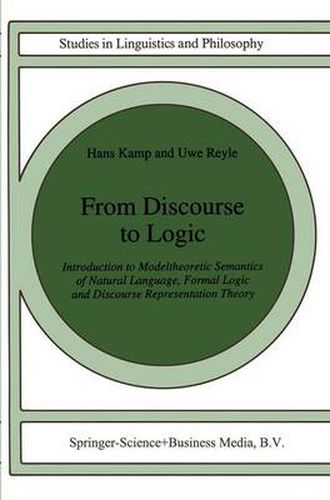Readings Newsletter
Become a Readings Member to make your shopping experience even easier.
Sign in or sign up for free!
You’re not far away from qualifying for FREE standard shipping within Australia
You’ve qualified for FREE standard shipping within Australia
The cart is loading…






This title is printed to order. This book may have been self-published. If so, we cannot guarantee the quality of the content. In the main most books will have gone through the editing process however some may not. We therefore suggest that you be aware of this before ordering this book. If in doubt check either the author or publisher’s details as we are unable to accept any returns unless they are faulty. Please contact us if you have any questions.
Preface This book is about semantics and logic. More specifically, it is about the semantics and logic of natural language; and, even more specifically than that, it is about a particular way of dealing with those subjects, known as Discourse Representation Theory, or DRT. DRT is an approach towards natural language semantics which, some thirteen years ago, arose out of attempts to deal with two distinct problems. The first of those was the semantic puzzle that had been brought to contempo rary attention by Geach’s notorious donkey sentences - sentences like If Pedro owns some donkey, he beats it, in which the anaphoric connection we perceive between the indefinite noun phrase some donkey and the pronoun it may seem to conflict with the existential meaning of the word some. The second problem had to do with tense and aspect. Some languages, for instance French and the other Romance languages, have two morphologically distinct past tenses, a simple past (the French Passe Simple) and a continuous past (the French Imparfait). To articulate precisely what the difference between these tenses is has turned out to be surprisingly difficult.
$9.00 standard shipping within Australia
FREE standard shipping within Australia for orders over $100.00
Express & International shipping calculated at checkout
This title is printed to order. This book may have been self-published. If so, we cannot guarantee the quality of the content. In the main most books will have gone through the editing process however some may not. We therefore suggest that you be aware of this before ordering this book. If in doubt check either the author or publisher’s details as we are unable to accept any returns unless they are faulty. Please contact us if you have any questions.
Preface This book is about semantics and logic. More specifically, it is about the semantics and logic of natural language; and, even more specifically than that, it is about a particular way of dealing with those subjects, known as Discourse Representation Theory, or DRT. DRT is an approach towards natural language semantics which, some thirteen years ago, arose out of attempts to deal with two distinct problems. The first of those was the semantic puzzle that had been brought to contempo rary attention by Geach’s notorious donkey sentences - sentences like If Pedro owns some donkey, he beats it, in which the anaphoric connection we perceive between the indefinite noun phrase some donkey and the pronoun it may seem to conflict with the existential meaning of the word some. The second problem had to do with tense and aspect. Some languages, for instance French and the other Romance languages, have two morphologically distinct past tenses, a simple past (the French Passe Simple) and a continuous past (the French Imparfait). To articulate precisely what the difference between these tenses is has turned out to be surprisingly difficult.